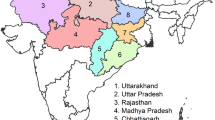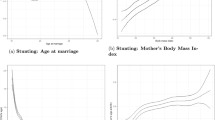Abstract
Malnutrition among women has severe consequences on their health, households and national development. The different forms of malnutrition among adult individuals are severe thinness, underweight, overweight and obesity which are usually assessed using height and weight indices calculated as body mass index (BMI). In this study, the spatial distributions of the various forms of malnutrition measured at the upper and lower tails of the BMI were accessed among women of reproductive age in Nigeria after accounting for the influence of socio-economic factors. Bayesian quantile regression that permits for inference on conditional quantiles, yielding a complete description of the functional changes among covariates at different quantiles of the response variable was adopted. Markov random field and Bayesian P-splines were used as prior distributions for the spatial and nonlinear effects respectively, while computation was based on MCMC approach. Data were derived from the 2013 Nigeria Demographic and Health Survey. Findings indicate the existence of spatial structure in the various forms of malnutrition with neighbouring states sharing similar patterns and that the socio-economic variables exact dissimilar influence on the various forms of malnutrition. The study provides valuable insights for policy makers in the quest for halting all forms of malnutrition among Nigerian women.



Similar content being viewed by others
References
Ahmed, T., Hossain, M., & Sanin, K. I. (2011). Maternal obesity: Implications for pregnancy outcome and long-term risks-a link to maternal nutrition. International Journal of Gynecology and Obstetrics, 115(Suppl 1), S6–S10.
Ahmed, T., Hossain, M., & Sanin, K. I. (2012). Global burden of maternal and child undernutrition and micronutrient deficiencies. Annals of Nutrition and Metabolism, 61(Suppl 1), 8–17.
Akseer, N., Bhatti, Z., Mashal, T., Soofi, S., Moineddin, R., & Black, R. E. (2018). Geospatial inequalities and determinants of nutritional status among women and children in Afghanistan: An observational study. The Lancet Global Health, 6(4), PE447–E459.
Babalola, S., & Fatusi, A. (2009). Determinants of use of maternal health services in Nigeria-looking beyond individual and household factors. BMC Pregnancy and Childbirth, 9, 43.
Belitz, C., Brezger, A., Klein, N., Kneib, T., Lang, S., Umlauf, N. (2015). Bayesx—software for Bayesian inference in structured additive regression models, version 3.0.2. http://www.bayesx.org
Bharati, S., Pal, M., Bhattacharya, B. N., & Bharati, P. (2007). Prevalence and causes of chronic energy deficiency and obesity in Indian women. Human Biology, 79(4), 395–412.
Brezger, A., & Lang, S. (2006). Generalized structured additive regression based on Bayesian P-splines. Computational Statistics and Data Analysis, 50(4), 967–991.
Cesare, M. D., Bhatti, Z., Soofi, S. B., Fortunato, L., Ezzati, M., & Bhutta, Z. A. (2015). Geographical and socioeconomic inequalities in women and children’s nutritional status in Pakistan. The Lancet Global Health, 3(4), PE229–E239.
Denison, F. C., Roberts, K. A., Barr, S. M., & Norman, J. E. (2010). Obesity, pregnancy, inflammation, and vascular function. Reproduction, 140(3), 373–385.
Duda, R. B., Darko, R., Saffah, J., Adanu, R. M., Anarfi, J. K., & Hill, A. G. (2007). Prevalence of obsesity among women in Accra, Ghana. African Journal of Health Sciences, 14(3), 154–159.
Fahrmeir, L., & Kneib, T. (2011). Bayesian smoothing and regression for longitudinal, spatial and event history data. Oxford statistical science series. Oxford: Oxford University Press.
Gayawan, E. (2014). Spatial analysis of choice of place of delivery in Nigeria. Sexual and Reproductive Healthcare, 5(2), 59–67.
Gayawan, E., Adebayo, S. B., Komolafe, A. A., & Akomolafe, A. A. (2017). Spatial distribution of malnutrition among children under five in Nigeria: A Bayesian quantile regression approach. Applied Spatial Analysis and Policy. https://doi.org/10.1007/s12061-017-9240-8.
Gewa, C. A., Leslie, T. F., & Pawloski, L. R. (2013). Geographic distribution and socio-economic determinants of women’s nutritional status in Mali households. Public Health Nutrition, 16(9), 1575–1585.
Griffiths, P., & Bentley, M. (2005). Women of higher socio-economic status are more likely to be overweight in Karnataka, India. European Journal of Clinical Nutrition, 59(10), 1217–1220.
Haile, D., Azage, M., Mola, T., & Rainey, R. (2016). Exploring spatial variations and factors associated with childhood stunting in Ethiopia: Spatial and multilevel analysis. BMC Pediatrics, 16, 49.
Hong, X., & Ye, X. (2018). Exploring the influence of land cover on weight loss awareness. GeoJournal, 83(5), 935–947.
Kamal, M., & Islam, M. A. (2010). Socio-economic correlates of malnutrition among married women in Bangladesh. Malasia Journal of Nutrition, 16(3), 349–359.
Kandala, N. B., Fahrmeir, L., Klasen, S., & Priebe, J. (2009). Geo-additive models of childhood undernutrition in three sub-Saharan African countries. Population, Space and Place, 15(5), 461–473.
Kandala, N. B., & Stranges, S. (2014). Geographic variation of overweight and obesity among women in Nigeria: A case for nutritional transition in sub-Saharan Africa. PLoS ONE, 9(e101), 103.
Kitsantas, P., & Pawloski, L. R. (2010). Maternal obesity, health status during pregnancy, and breastfeeding initiation and duration. The Journal of Maternal-Fetal and Neonatal Medicine, 23(2), 135–141.
Koenker, R., & Bassett, J. G. (1978). Regression quantiles. Econometrica, 46(1), 33–50.
Lang, S., & Brezger, A. (2004). Baysian P-splines. Journal of Computational and Graphical Statistics, 13(1), 183–212.
Letamo, G., & Navaneetham, K. (2014). Prevalence and determinants of adult under-nutrition in Botswana. PLoS ONE, 9(e102), 675.
Liu, J., Smith, M. A., & Ferguson, J. E. (2010). Maternal obesity and breast-feeding practices among white and black women. Obesity: A Research Journal, 18(1), 175–182.
Monda, K. L., Adair, L., Zhai, F. G., & Popkin, B. (2008). Longitudinal relationships between occupational and domestic physical activity patterns and body weight in China. European Journal of Clinical Nutrition, 62(11), 1318–1325.
Mtambo, O. P. L., Masangwi, S. J., & Kazembe, L. M. (2015). Spatial quantile regression using INLA with applications to childhood overweight in Malawi. Spatial and Spatio-temporal Epidemiology, 13, 7–14.
Muller, O., & Krawinkel, M. (2005). Malnutrition and health in developing countries. Canadian Medical Association Journal, 173(3), 279–286.
Normal, J. E., & Reynolds, R. (2011). The consequences of obesity and excess weight gain in pregnancy. Proceedings of the Nutrition Society, 70(4), 450–456.
NPC, & ICF International. (2014). Nigeria demographic and health survey 2013. National Population Commission [Nigeria] and ICF International, Abuja, Nigeria and Rockville, Maryland, USA.
Popkin, B. M. (1993). Nutrition patterns and transition. Population and Development Review, 19(1), 138–157.
Popkin, B. M. (1998). The nutrition transition and its health implications in lower-income countries. Public Health Nutrition, 1(1), 5–21.
Rossington, C. E. (1981). Environmental aspects of child growth and nutrition: A case study from Ibadan, Nigeria. GeoJournal, 5(4), 347–356.
Samouda, H., Ruiz-Castell, M., Bocquet, V., Kuemmerle, A., Chioti, A., Dadoun, F., et al. (2018). Geographical variation of overweight, obesity and related risk factors: Findings from the European health examination survey in Luxembourg. PLoS ONE, 13(e0197), 021.
Sobal, J., & Stunkard, A. J. (1989). Socioeconomic status and obesity: A review of the literature. Psychological Bulletin, 105(2), 260–275.
Tchicaya, A., & Lorentz, N. (2012). Socioeconomic inequality and obesity prevalence trends in Luxembourg, 1995–2007. BMC Research Notes, 5, 467.
Tebekaw, Y., Teller, C., & Colon-Ramos, U. (2014). The burden of underweight and overweight among women in Addis Ababa, Ethiopia. BMC Public Health, 14, 1126.
Tomkins, A. (2001). Nutrition and maternal morbidity and mortality. British Journal of Nutrition, 85(Suppl 2), S93–S99.
UNICEF. (2009). Tracking progress on child and maternal nutrition: A survival and development priority. New York: United Nations Children Fund.
Uyanga, J. (1981). The regional correlates of child nutrition in rural Southeastern Nigeria. GeoJournal, 5(4), 331–338.
Waldmann, E., Kneib, T., Yue, Y. R., Lang, S., & Flexeder, C. (2013). Bayesian semiparametric additive quantile regression. Statistical Modelling, 13, 223–252. https://doi.org/10.1177/1471082X13480650.
WHO. (2017). Malnutrition: Fact sheet. Geneva: World Health Organization.
Yadav, A., Ladusingh, L., & Gayawan, E. (2015). Does a geographical context explain regional variation in child malnutrition in India? Journal of Public Health, 23(5), 277–287.
Yu, K., & Moyeed, R. A. (2001). Bayesian quantile regression. Statistics and Probability Letters, 54(4), 437–447.
Yue, Y., & Rue, H. (2011). Bayesian inference for additive mixed quantile regression models. Computational Statistics and Data Analysis, 55(1), 84–96.
Acknowledgements
This work was supported with a grant from UNICEF’s Nigeria Country office but the design, analysis and interpretation of results were carried out by the authors without any role by UNICEF. We appreciate Measure DHS for granting access to the data and useful comments from Elisabeth Waldmann on Bayesian quantile regression.
Author information
Authors and Affiliations
Corresponding author
Ethics declarations
Conflict of interest
The authors have no conflict of interest to declare.
Ethical Standard
The data used in this study was obtained from The DHS Program (https://dhsprogram.com), who was the main partner that conducted the survey, after approval was given to our request.
Rights and permissions
About this article
Cite this article
Akeresola, R.A., Gayawan, E. Analysis of the spatial patterns of malnutrition among women in Nigeria with a Bayesian structured additive model. GeoJournal 85, 81–92 (2020). https://doi.org/10.1007/s10708-018-9958-0
Published:
Issue Date:
DOI: https://doi.org/10.1007/s10708-018-9958-0




